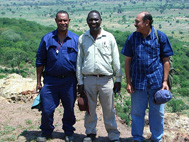About TanzaniaTanzania is a diamond producing nation, hosting one of the largest mined kimberlites in the world - the 146 hectare Mwadui/Williamson's mine - one of over 300 discovered in the country. The country is also the third largest gold producer in Africa and enjoys increasing investment in the mining of this commodity. Much of the country remains relatively unexplored, and with modern techniques yet to be applied in the search for diamond, precious and base metal deposits, Leland is confident that Tanzania has unparalleled potential for the discovery of major mines. Increasing literacy rates and recent advances in infrastructure allow Leland to operate with relative ease in this rapidly developing country. Current diamond production in Tanzania has one of the highest average dollar per carat values in Africa, with 70% of production being gem quality. Tanzania is also the third largest gold producer in Africa. www.tanzaniagold.com The average value of diamonds mined from the Mwadui kimberlite is US$145 (in 2005) per carat, one of the highest in Africa from primary deposits. The gem percentage is around 70% - an increase of 40% compared to an average kimberlite. While no extrapolations as to the possible average value of diamonds in other deposits should be made, it is reasonable to conclude that low overburden thicknesses (a few metres in most cases) is a significant contributory factor to potentially low stripping ratios and therefore attractive mining costs. Nominal overburden and possible high value diamond deposits combine to make an extremely attractive investment opportunity. Tanzania is the third-largest gold producer in Africa, with six new mines having opened in the last decade. Highly stable political and fiscal environment with clear mining legislation Tanzania enjoys a stable political environment, see www.tanzaniangov.com. The government is committed to pursuing pro-investment and pro-growth policies and has clear mining legislation. The country has benefited from a number of mines developed since the early 1990s and there are several tax and other incentives offered to mineral explorers. Long-term economic growth through 2005/6 featured a notable rise in industrial production and a substantial increase in output of minerals, led by gold. Recent banking reforms have helped increase private-sector growth and investment. Solid macroeconomic policies, combined with continued Ronor assistance, supported real GDP growth of nearly 6% in 2006. Inflation in 2006 was 6.1%. (Source: CIA)
|
    |



